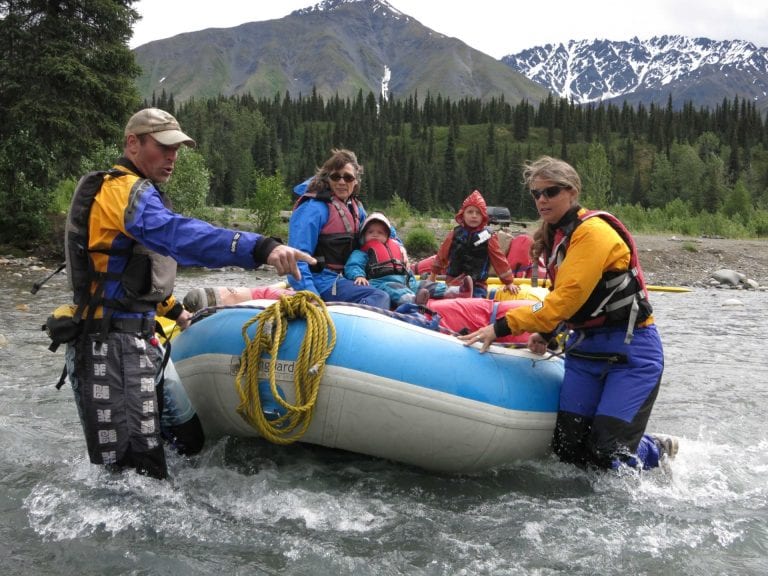Eager to see bears, moose and wolves in the wild, walk on a glacier or hike in the majestic Talkeetna and Chugach mountains, visitors to south central Alaska routinely drive right by the small communities in the traditional territory of Chickaloon Native Village. Jessica Winnestaffer is determined to change that. The tribal biologist and Environmental Stewardship Director wants to put Chickaloon Village squarely on the radar of tourists, and to do so, she recently launched a tribal initiative that she describes as still in its infancy. To nurture it along, she enrolled in the Cultural Heritage Tourism Professional Certificate Program, jointly offered by the International Institute of Tourism Studies and the American Indian Alaska Native Tourism Association. The six-week, self-managed program is designed to provide tourism entrepreneurs and community leaders with the tools to identify and develop local assets that would most appeal to tourists—from cooking and crafts workshops to nature walks to historical sites.
For rural communities like those around Chickaloon Village, which once relied heavily on coal mining, tourism can provide both an alternative source of income to toxic extractive industries and a huge incentive to protect cultural and natural resources.
The cultural fabric of Chickaloon ’s and the Ahtna people was severely fractured over many years by government attempts at assimilation. Between the late 19th and early mid 20th centuries, native Indigenous children across the country, including Alaska, were taken from their families and sent to boarding schools, where they were forced to speak English and severely punished for stop speaking their languages and practicing their customs. Winnestaffer believes that tourism can help to heal the community’s painful history, instill a communal sense of pride and generate revenue.
Today, only a handful of community members speak Ahtna, which they learned as a second language. The last surviving Chickaloon Ahtna speaker— the Elder Katherine “Katie” Wade, who learned the language from her grandparents— died in 2009.
Children of the community may attend the only tribally-operated school in Alaska, where they learn Ya Ne Dah Ah, which means “our ancient teachings.” These teachings include lessons in culture, history, language, storytelling, sewing, beading, fishing and hunting. Winnestaffer would like to share some of them with visitors.
While she’s a scientist by training and new to tourism, Winnestaffer is proficient in securing grants. Before taking the GW courses, she’d already applied for and received funds to train five Ahtna Cultural Tour Guides, including several young people between 17 and 25. While the grant covered their salaries and training, she needed guidance to better understand what a professionally run tourism program entails—how to identify, develop and promote the assets and activities that most appeal to visitors, how to manage local and small businesses, and how convince community members—many of whom tend to be wary at first—of the benefits of hosting tourists.
“For a novice like me, the GW program provided a good introduction. I particularly appreciated the cultural focus,” reflected Winnestaffer. “Rather than tourism generally, which is what’s usually available, the courses addressed issues that were of specific relevance to tribes and heritage tourism.”
While she found that courses included participants who, like her, were still early in their journeys, it was inspiring to hear about the experiences of individuals who were further along. In fact the networking aspect of the program was especially worthwhile for her. “It was so valuable to learn about who’s doing what and to have their contact information,” she explained.
Winnestaffer found that the material was well-organized, presentations were easy to follow and the topics covered addressed her concerns. “Because the lessons were pre-recorded, the instructors could really plan their lectures and I appreciated that,” praised Winnestaffer.
She did find, however, that because participants were varied in their level of expertise, some of the information, particularly around marketing, was advanced. “But that doesn’t mean I didn’t find it worthwhile,” she noted. “It helped me to understand what I’d need to know as we further develop our tourism program.”
Winnestaffer’s next step is to conduct a cultural tourism assessment—a concept that was brand new to her just a few weeks ago. “I have a toolkit and I understand how to use it,” she offered with obvious enthusiasm. “Now I’m thinking about how best and most strategically to approach this next phase of the work.”
Given Winnestaffer’s thoughtfulness and commitment to the task, there’s little doubt that before long many of the tourists who make their way up the Glenn Highway between Anchorage and Glennallen each summer will soon be stopping off to explore the cultural heritage of Chickaloon Native Village.
For more information on the certificate program in cultural heritage tourism, please email culturaltourism@gwu.edu or visit our website.

